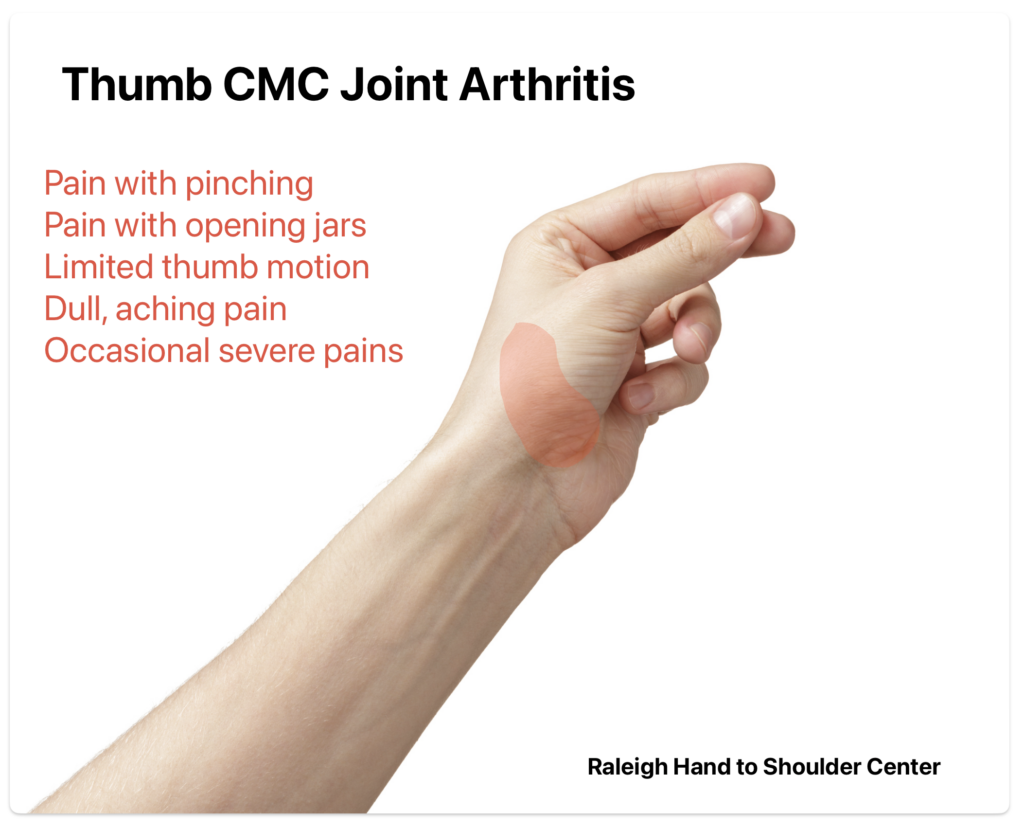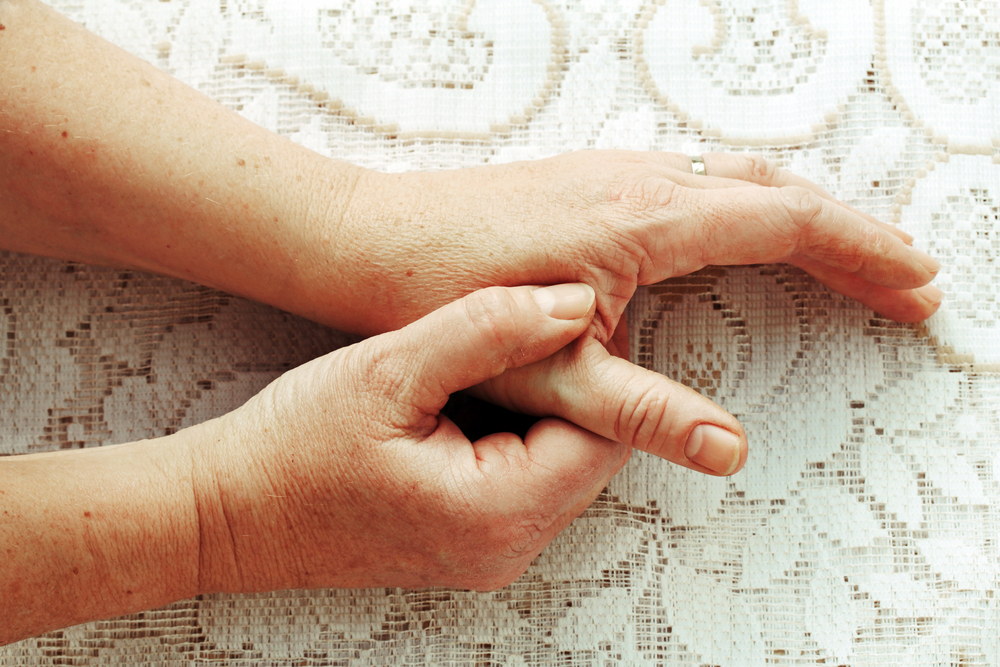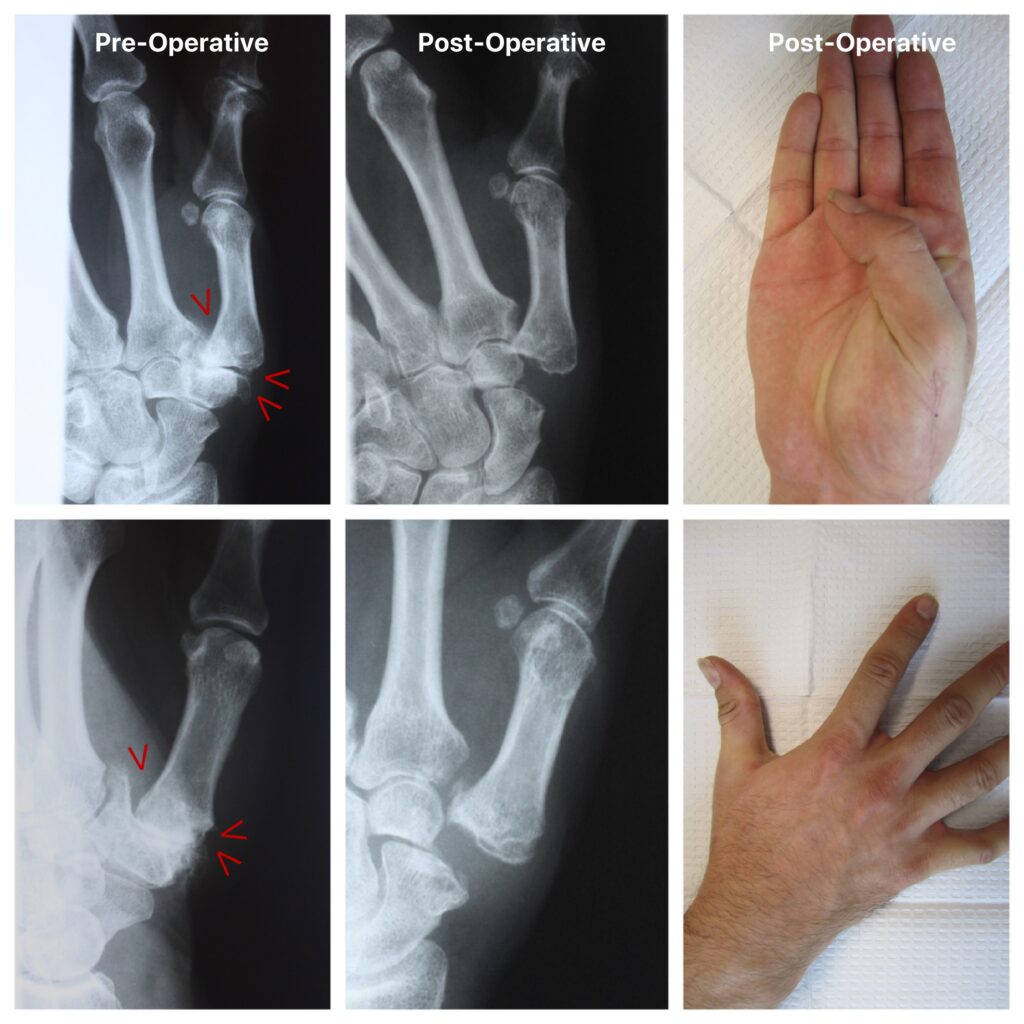
Thumb CMC Arthritis
What is Thumb CMC Arthritis?
Thumb CMC joint arthritis (also called basilar thumb arthritis) is a very common type of arthritis in the hand. Similar to arthritis in other areas of the body, it develops from the normal "wear and tear" of our joints as we age. Typically, arthritis at this joint occurs after 40-50 years of age, and it is much more common in women than men. This type of arthritis is called osteoarthritis.

Why Does Arthritis Develop in the Thumb CMC Joint?
All joints are subject to pressure across them with normal use. Walking, for instance, causes pressure across the knee joint that over time can wear out the joint. Ligaments around the joint provide stability so there is more uniform pressure on the joint. The basilar thumb joint, or thumb carpometacarpal (CMC) joint, has significant pressure across it with normal everyday hand use. The joint can become unstable from ligament stretching or weakening with normal aging. Over time, the combination of instability and high pressure across the joint, leads to wear and tear arthritis of the thumb CMC joint and loss of joint cartilage. The thumb CMC joint is used everyday for opening jars, using a key, and turning door knobs, among other common tasks.
What Are the Common Symptoms of Thumb CMC Arthritis?
Pain in the area of the thumb joint is typical, but the pain can radiate into the wrist and into the thumb. The pain can be mild, “achy” pain early on but can progress to severe pain that limits the use of the hand. Activities that involve forceful grip or pinch often increase the pain. Patients with thumb CMC arthritis often have difficulty opening jars or medicine bottles. Use of keys can be painful as well as lifting heavy items around the home. A deformity may occur over time making it difficult to hold objects that have a large diameter.

What Treatment Options are available for Thumb CMC Joint Arthritis?
The physician will usually get an x-ray of the hand to confirm the diagnosis. X-rays usually show decreased joint space and bone spurs around the joint. Treatment often depends on the severity of the symptoms. In patients with mild symptoms, activity modification to avoid forceful pinch activities and occasional oral and topical anti-inflammatory medications (NSAIDs) may be sufficient to relieve the symptoms. Patients can also benefit from the use of a thumb support brace. Hand therapy can also be helpful for patients. If symptoms are more severe, a cortisone injection is often recommended to reduce the pain. In severe cases which do not improve with conservative treatments, surgery may be recommended.
What is Thumb CMC Arthritis Surgery?
The most common type of surgery for thumb CMC joint arthritis is called thumb CMC arthroplasty. This surgery can be performed on an outpatient basis under regional anesthesia (nerve block) and IV sedation. Surgical techniques vary, but most thumb CMC joint arthroplasty surgeries involve removal of the arthritic bone to eliminate the bone-on-bone arthritis pain. Depending on the treating surgeon and patient factors, sometimes the joint ligaments are reconstructed with a tendon graft or the joint can be stabilized with suture suspension or a tightrope implant. Sometimes a patient's own forearm tendon can be used as a graft during the surgery to cushion the joint or reconstruct the thumb ligaments. These various surgical options can be explained to patients in our office.
X-rays in the images below show bone-on-bone arthritis as well as bone spurs at the thumb CMC joint, marked with the red arrows. After thumb CMC arthroplasty surgery, the x-rays show the new joint space. The patient's thumb range of motion is shown in the photographs.

What Are the Potential Complications Associated with Thumb CMC Arthritis Surgery?
Although complications are rare, infection, scar tissue, blood vessel injury, nerve injury, continued pain, and thumb deformity can occur after the surgery. Sometimes there is numbness and tingling in the thumb after surgery.
What is the Recovery Process After Thumb CMC Arthritis Surgery?
At 10-14 days after surgery, the stitches are removed from the incisions, and the patient is provided with a custom splint in our therapy department. The healing thumb is protected for about 6 weeks with a removable splint. A hand therapy program is started soon after surgery to improve pain, thumb range of motion, and hand strength. Patients can return to light use with the hand within a few days after the surgery and return to light duty work in a few days. Heavier activities with the hand are resumed several weeks after the surgery, as the thumb heals. Full, unrestricted hand activities are usually possible 10-12 weeks after the surgery. Most patients are very pleased with the outcome of the surgery, and the surgical results can last a lifetime. Revision surgery for this condition is occasionally needed, but this is not common.
Relieve Thumb CMC Arthritis Pain at Raleigh Hand to Shoulder Center
Thumb CMC arthritis can make simple tasks painful and frustrating. Don't let this condition limit your lifestyle. At Raleigh Hand to Shoulder Center, we offer treatments and support to help you regain control of your thumb and hand. Call our office to make an appointment or book a visit with us online!
Updated 6/23/2025
Video provided by the American Society for Surgery of the Hand.


